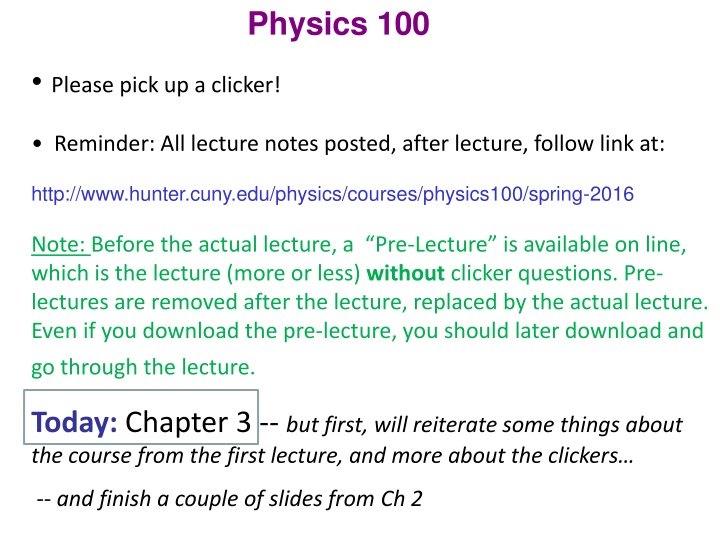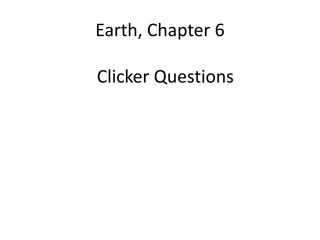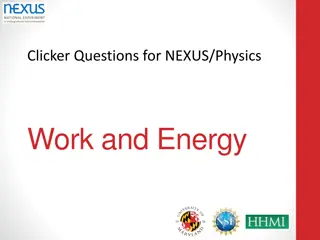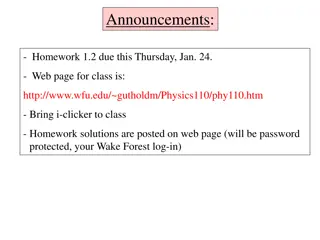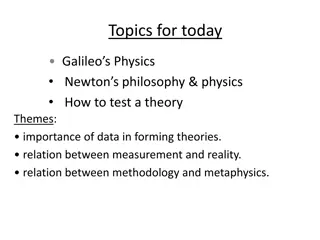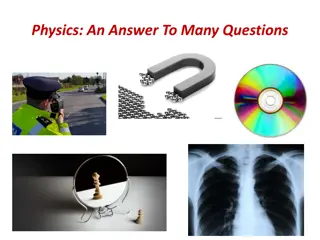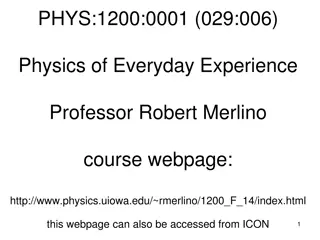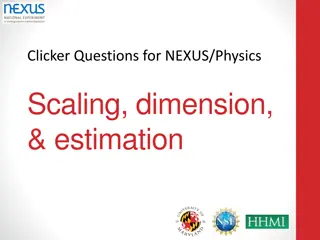Physics 100 Course Information and Clicker Instructions
This message provides detailed information regarding the Physics 100 course, including location, instructor details, textbook information, grading breakdown, and the use of clickers for interactive learning. Students are encouraged to participate actively in lectures through clicker responses and discussions with peers. The content emphasizes the importance of attendance, participation, and engagement with the material presented in the course.
Download Presentation

Please find below an Image/Link to download the presentation.
The content on the website is provided AS IS for your information and personal use only. It may not be sold, licensed, or shared on other websites without obtaining consent from the author.If you encounter any issues during the download, it is possible that the publisher has removed the file from their server.
You are allowed to download the files provided on this website for personal or commercial use, subject to the condition that they are used lawfully. All files are the property of their respective owners.
The content on the website is provided AS IS for your information and personal use only. It may not be sold, licensed, or shared on other websites without obtaining consent from the author.
E N D
Presentation Transcript
Physics 100 Please pick up a clicker! Reminder: All lecture notes posted, after lecture, follow link at: http://www.hunter.cuny.edu/physics/courses/physics100/spring-2016 Note: Before the actual lecture, a Pre-Lecture is available on line, which is the lecture (more or less) without clicker questions. Pre- lectures are removed after the lecture, replaced by the actual lecture. Even if you download the pre-lecture, you should later download and go through the lecture. Today: Chapter 3 -- but first, will reiterate some things about the course from the first lecture, and more about the clickers -- and finish a couple of slides from Ch 2
Course information (on your handout) Location: Room HW 511 Lecture Times: Tu and Fr: 2.10pm - 3.25pm Instructor: Neepa Maitra email: nmaitra@hunter.cuny.edu phone: 212-650-3518 office: 1214E HN Office hours: Tu and Fr: 12.00pm-1.00pm or, by appointment. Text:Conceptual Physics, 12th Edition, by Paul G. Hewitt (Pearson, Addison-Wesley, 2014). But 9th ,10th ,and 11th editions are also fine. Lectures posted on-line afterlecture: (but a pre-lecture will be posted here before class, see shortly) http://www.hunter.cuny.edu/physics/courses/physics100/fall-2016 Grading: Attendance/Participation Midterm Exams Final Exam 5% 50% 45% (2) Attendance/Participation: We will make use of clickers in this course (from second lecture onwards), and also have questions to discuss in class. Midterms: Two mid-term in-class multiple-choice exams: Fri Sep 30 and Fri Nov 18. Final Exam: TBD, 11.30am 1.30pm, cumulative, all multiple-choice.
Important Note! This is a one-semesterterminal physics course, and it does not fulfill the pre-med physics requirement. Another note: PHYS 100 fulfills the Scientific World category of the Flexible Core of Pathways. It is a pre/co-requisite of the lab-including course PHYS 101, of the Life and Physical Sciences category (but you may take 100 without taking 101). Note from the Office of Student Services:
Clickers and Peer Instruction All the lectures incorporate a few multiple-choice questions that test the concepts we are learning. You individually enter answers via a clicker, and a bar graph is instantly generated for us to see how you all answered. Then, you will be asked to discuss with your neighbor, and convince them of your answer*! After a few minutes, you all re-enter answers individually and we will all see what happens to the bar graph! Participation in this is very important, and useful for you (and fun!). Attendance will also be monitored via the clickers you will enter a 4-digit number of your choice to identify you at one point of the lecture. Please write your choice on the roster passed around in class. Importantly, it is your participation that will give you course credit (5%) for this, NOT the correctness of your actual answers individual answers are never correlated with individuals. * Original idea of Eric Mazur, Harvard University, Peer Instruction
Trial Clicker Question! Please turn on your clickers. What is Hunter s motto, translated into English? Mihi Cura Futuri A) Ours is to care about your future B) The care of the future is mine C)The care of the future is yours D) Why do today what you can do in the future? E) The future is yours to keep
OK ! Now continuing from last class . Recall -- Newton s first law -- inertia -- forces -- equilibrium
Clicker Question In which situation is the object in equilibrium? A) A train accelerating along a track B) A cart rolling on the floor and slowing down. C) A man cycling down a straight road at constant speed. D) A man on a bike going faster and faster downhill on a straight road without pedaling. E) An object can only be in equilibrium if it is completely at rest. Answer: C Equilibrium means all forces balance, i.e. add to zero, i.e. zero net force on the object. Then, an object at rest remains at rest, or an object moving at constant speed in a straight line keeps going at constant speed in the same straight line. There are forces acting on the man going at constant speed, but they must cancel to zero since otherwise he would be changing his speed
The moving Earth Earth is moving around the sun at 30 km/sec = 107 000 km/h. So, if I stand near a wall, and jump up in the air for a few seconds, why doesn t the wall slam into me?? Because of inertia. While standing on the ground, I am moving along with the earth at 30 km/s, and when I jump, I (and the air) continue moving (sideways) at 30 km/s.
Clicker Question When the pellet fired into the spiral tube emerges, which path will it follow? (Neglect gravity).
Answer When the pellet fired into the spiral tube emerges, which path will it follow? (Neglect gravity). B: While in the tube, the pellet is forced to curve, but when it gets outside, no force is exerted on the pellet and (law of inertia) it follows a straight-line path hence, B.
Clicker Question When the ball at the end of the string swings to its lowest point, the string is cut by a sharp razor. What path will the ball then follow?
Answer When the ball at the end of the string swings to its lowest point, the string is cut by a sharp razor. What path will the ball then follow? b) At the moment the string is cut, the ball is moving horizontally. After the string is cut, there are no horizontal forces, so the ball continues horizontally at constant speed. But there is the force of gravity which causes the ball to accelerate downward, so the ball gains speed in the downward direction. The combination of constant horiz. speed and downward gain in speed produces the curved (parabolic) path..
Chapter 3: Linear Motion Preliminaries Linear motion is motion in a straight line. Note that motion is relative: e.g. your paper is moving at 107 000 km/hr relative to the sun. But it is at rest relative to you. Unless otherwise stated, when we talk about speed of things in the environment, we will mean relative to the Earth s surface.
Clicker Question Suppose you and a pair of life preservers are floating down a swift river, as shown. You wish to get to either of the life preservers for safety. One is 3 meters downstream from you and the other is 3 meters upstream from you. Which can you swim to in the shortest time? 1. The preserver upstream. 2. The preserver downstream 3. Both require the same.
Suppose you and a pair of life preservers are floating down a swift river, as shown. You wish to get to either of the life preservers for safety. One is 3 meters downstream from you and the other is 3 meters upstream from you. Which can you swim to in the shortest time? 1. The preserver upstream. 2. The preserver downstream 3. Both require the same. Answer: 3, same time. You, and both life preservers are moving with the current relative to you before you start swimming, neither of the life preservers are moving. An analogy: We can think of things on earth as being in a current traveling at 107 000 km/h relative to sun.
Speed Speed measures how fast : distance time Speed = Units: eg. km/h, mi/h (or mph), m/s meters per second, standard units for physics
Instantaneous vs Average Speed Things don t always move at the same speed, e.g. car starts at 0 km/h, speed up to 50 km/h, stay steady for a while, and then slow down again to stop. average speed = average of the instantaneous speeds over the time interval but also speed 50 km/h 0 km/h time total distance covered time interval Average speed =
Eg. Usain Bolt ran 100m in 9.58s in 2009. What was his average speed during that run? Average speed = distance/time = 100m/9.58s = 10.4 m/s How much distance did he cover per second, on average? 10.4 m, by definition of average speed How did this relate to his top speed? (i.e. is it greater or less or the same) Top speed is greater (actually about 10% over !)
Velocity Velocity is speed in a given direction (velocity is a vector, speed is a scalar) E.g. 5 km/h northwest is a velocity; 5km/h is a speed When there s just one direction of interest (e.g. up or down), often indicate direction by + or - Note that an object may have constant speed but a changing velocity Eg. Whirling a ball at the end of a string, in a horizontal circle same speed at all times, but changing directions. Or, think of a car rounding a bend, speedometer may not change but velocity is changing, since direction is.
Acceleration Measures how quickly velocity changes: Acceleration = change of velocity time interval E.g. We feel acceleration when we lurch backward in the subway (or car, bike etc) when it starts, or when it stops (lurch forward), or turns (lean to one side) Note acceleration refers to : decreases in speed, increases in speed, and/or changes in direction i.e. to changes in the state of motion. Newton s 1st law says then there must be a force acting (more next lecture) Note also that acceleration has a direction
Clicker Question What is the acceleration of a cheetah that zips past you going at a constant velocity of 60 mph? A) 0 B)60 mi/h2 C)Not enough information given to answer problem D) None of the above
Answer What is the acceleration of a cheetah that zips past you going at a constant velocity of 60 mph? Constant velocity means no change in velocity i.e. no acceleration A) 0 B)60 mi/h2 C)Not enough information given to answer problem D) None of the above
Questions A certain car goes from rest to 100 km/h in 12 s = 1 acceleration? (100 0) km/h/ (1 a) 5 h. What is its 5) h = 500 km/h2 b) In 2 s, a car increases its speed from 60 km/h to 65 km/h while a bicycle goes from rest to 5 km/h. Which undergoes the greater acceleration? The accelerations are the same, since they both gain 5 km/h in 2s, so acceleration = (change in v)/(time interval) = (5 km/h)/(2 s) = 2.5 km/h.s (note units ) c) What is the average speed of each vehicle in that 2 s interval, if we assume the acceleration is constant ? For car: 62.5 km/h For bike: 2.5 km/h
Clicker Question Can an object have zero acceleration but non-zero velocity ? A)Yes B)No Answer: A) Yes This just means it is moving at constant speed in a constant direction. e.g. a hockey puck on ice after it s been hit e.g. in outer space far enough from any planet or star etc.
Another Clicker Question Can an object have zero velocity but non-zero acceleration? A)Yes B)No Answer: A) Yes! Eg. Throw a ball up in the air at the top of its flight, as it turns around it has momentarily zero speed but is changing its direction of motion, so has non-zero acceleration.
Id like to take attendance now. Please enter your chosen 4-digit identification number and click send..
Free-Fall Free-fall: when falling object falls under influence of gravity alone (no air resistance, nor any other restraint). How fast? During each second of fall, the object speeds up by about 10 m/s (independent of its weight) Eg. Free-fall from rest Time(s) Velocity(m/s) Hence, free-fall acceleration = 10 m/s2 0 0 i.e. velocity gain of 10 meters per second, per second 1 10 2 20 We call this acc. due to gravity, g. Near surface of Earth, g = 9.8 m/s2 downwards. 3 30 .. .. t 10 t So write v = g t if object dropped from rest Note! We rounded g to 10 m/s2in the table
What happens if object is thrown upwards, instead of being dropped? Once released, it continues to move upwards for a while, then comes back down. At the top, its instantaneous speed is zero (changing direction); then it starts downward just as if it had been dropped from rest at that height. -- As it rises, it slows down at a rate of g. -- At the top, it has zero velocity as it changes its direction from up to down. -- As it falls, it speeds up at a rate of g. -- Equal elevations have equal speed (but opposite velocity)
Clicker Question A ball is thrown up in the air. What is acceleration as it rises and falls? A) g = 9.8 m/s2 downwards B) g = 9.8 m/s2 upwards as it rises and g = 9.8 m/s2 downwards as it falls C) It starts out with a small acceleration that decreases as it rises, then increases as it falls D) None of the above Answer: A The acceleration due to gravity is always g = 9.8m/s2 (near the surface of the earth) and points towards earth. When ball is thrown up, its speed decreases because acceleration (= rate of change of velocity) is in a direction opposite to its velocity. As it falls, it speeds up since acceleration is in the same direction as velocity. Don t confuse velocity and acceleration!
Free-fall continued: How far? i.e. what distance is travelled? From the sketch before, we see distance fallen in equal time intervals, increases as time goes on. Actually, one can show (appendix in book), for any uniformly accelerating object starting from rest, distance travelled, d = (acceleration x time x time) So in free-fall when dropped from rest : d = g t 2
Free-fall continued: in free-fall when dropped from rest: d = g t 2 Aside: Notice that in the 1st second, the distance is 5m, so the average speed is 5 m/s. Free-fall: Time(s) Distance fallen(m) 0 0 1 5 2 20 3 45 .. .. t 10 t2 On the other hand, the instantaneous speed at the beginning of the 1st sec ( ie t=0) is 0 and at the end of 1st sec is v = 10 m/s (earlier table). So, in this case, the average speed is the average of the initial and final speeds.
Application: Hang-time of jumpers Michael Jordan s best hang-time was 0.9 s this is the time the feet are off the ground. Let s round this to 1 s. How high can he jump? Use d = g t2 . For 1 s hang-time, that s s up and s down. So, substituting d = (10) (1/2)2 = 1.25 m This is about 4 feet! Note that good athletes, dancers etc may appear to jump higher, but very few can raise their center of gravity more than 4 feet.
Clicker Question Tracks A and B are made from pieces of channel iron of the same length. They are bent identically except for a small dip near the middle of Track B. When the balls are simultaneously released on both tracks as indicated, the ball that races to the end of the track first is on 1. Track A. 2. Track B. 3. Both reach the end at the same time.
Tracks A and B are made from pieces of channel iron of the same length. They are bent identically except for a small dip near the middle of Track B. When the balls are simultaneously released on both tracks as indicated, the ball that races to the end of the track first is on 1. Track A. 2. Track B. 3. Both reach the end at the same time. Answer: 2 The ball to win the race is the ball having the greatest average speed. Along each track both balls have identical speeds except at the dip in Track B. Instantaneous speeds everywhere in the dip are greater than the flat part of the track. Greater speed in the dip means greater overall average speed and shorter time for a ball on Track B. Note that both balls finish at the same speed, but not in the same time. Although the speed gained when going down the dip is the same as the speed lost coming out of the dip, average speed while in the dip is greater than along the flat part of the track. If this seems tricky, it s the classic confusion between speed and time.
Question (to think about) An airplane makes a straight back-and-forth round trip, always at the same airspeed, between two cities. If it encounters a mild steady tailwind going, and the same steady headwind returning, will the round trip take: 1. more 2. less 3. the same time as with no wind?
An airplane makes a straight back-and-forth round trip, always at the same airspeed, between two cities. If it encounters a mild steady tailwind going, and the same steady headwind returning, will the round trip take: Answer: 1: The windy trip will take more time. 1. more 2. less 3. the same time as with no wind? E.g. Suppose the cities are 600 km apart, and the airspeed of the plane is 300 km/h (relative to still air). Then time each way with no wind is 2 hours. Roundtrip time is 4 hours. Now consider a 100 km/h tailwind going, so groundspeed is (300 + 100) km/h. Then the time is (600 km)/(400km/h) = 1 hour and 30 minutes. Returning groundspeed is (300 100) km/h, and the time is (600 km)/(200km/h) = 3 hours. So the windy round trip takes 4.5 hours longer than with no wind at all.
